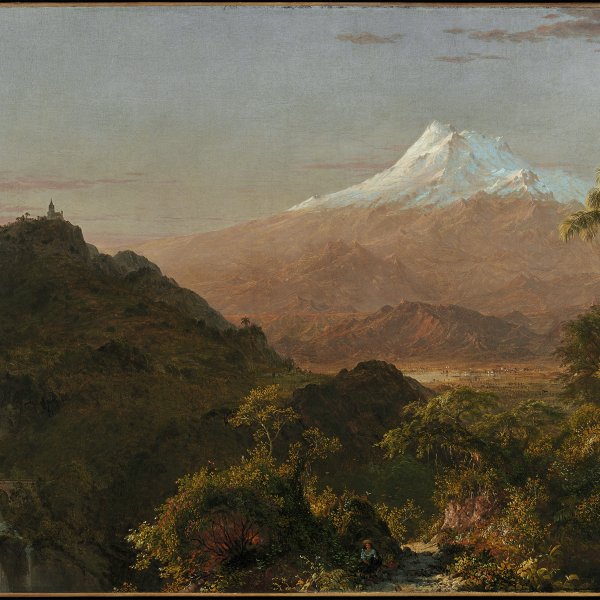Frederic Edwin Church
Hartford, 1826-New York, 1900
Frederic E. Church was the first student of Thomas Cole, the father of the Hudson River School, who instilled in him his allegorical and majestic vision of the American scenery, which is already apparent in the young painter’s earliest landscapes of New England. Little by little, the theories of John Ruskin, from whom Church learned that a thorough study of nature could reveal the essential truths of the world, distanced him from the moralistic and epic landscapes of his master. In 1845 he made his debut at the annual exhibition of the National Academy of Design, of which he later became a member and where his works were shown continuously throughout his career. His exhibition at the American Art Union in 1847 established him as one of the most promising young artists of the day.
The writings of the German naturalist Alexander von Humboldt (1769–1859) would have a determining influence on Church’s work. Cosmos taught him the harmonious unity of the universe, which Church translated into grandiose works combining broad panoramas with an almost scientific study of the details. Following in Humboldt’s footsteps, he made two trips to South America in spring 1853 and in 1857. The sketches he produced during his travels gave rise to some of the most memorable paintings of the Cayambe, Cotopaxi and Chimborazo volcanoes. He also made several visits to the Niagara Falls, another of the places of pilgrimage for painters of the time. The showing of his painting of The Niagara Falls (Washington, Corcoran Gallery of Art) in 1857 in New York, London and other European cities earned him a reputation as the great American painter.
In 1859 Church exchanged the tropical regions for the distant North. He visited the Labrador Peninsula, Newfoundland and painted several iceberg landscapes. His travelling companion Reverend Louis Legrand Noble, Thomas Cole’s biographer, published an account of the expedition in After Icebergs with a Painter (1861).
In 1860 Church, by then at the peak of his career, married Isabel Carnes and bought a plot of land overlooking the Hudson River, where he built Olana, a Persian-style country mansion where he spent his last years. His success began to wane in the 1870s and in 1880, suffering badly from rheumatism, he abandoned the large format and concentrated on decorating his house and depicting its appearance under different climatic conditions in small oil sketches. By the time he died in 1900 he was a forgotten artist.
The writings of the German naturalist Alexander von Humboldt (1769–1859) would have a determining influence on Church’s work. Cosmos taught him the harmonious unity of the universe, which Church translated into grandiose works combining broad panoramas with an almost scientific study of the details. Following in Humboldt’s footsteps, he made two trips to South America in spring 1853 and in 1857. The sketches he produced during his travels gave rise to some of the most memorable paintings of the Cayambe, Cotopaxi and Chimborazo volcanoes. He also made several visits to the Niagara Falls, another of the places of pilgrimage for painters of the time. The showing of his painting of The Niagara Falls (Washington, Corcoran Gallery of Art) in 1857 in New York, London and other European cities earned him a reputation as the great American painter.
In 1859 Church exchanged the tropical regions for the distant North. He visited the Labrador Peninsula, Newfoundland and painted several iceberg landscapes. His travelling companion Reverend Louis Legrand Noble, Thomas Cole’s biographer, published an account of the expedition in After Icebergs with a Painter (1861).
In 1860 Church, by then at the peak of his career, married Isabel Carnes and bought a plot of land overlooking the Hudson River, where he built Olana, a Persian-style country mansion where he spent his last years. His success began to wane in the 1870s and in 1880, suffering badly from rheumatism, he abandoned the large format and concentrated on decorating his house and depicting its appearance under different climatic conditions in small oil sketches. By the time he died in 1900 he was a forgotten artist.








